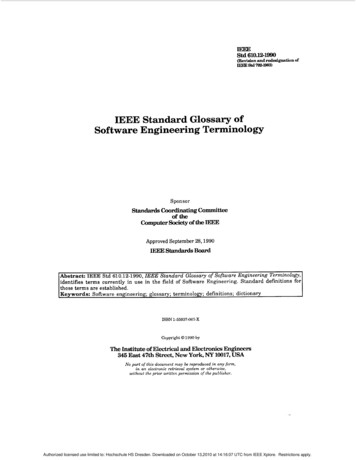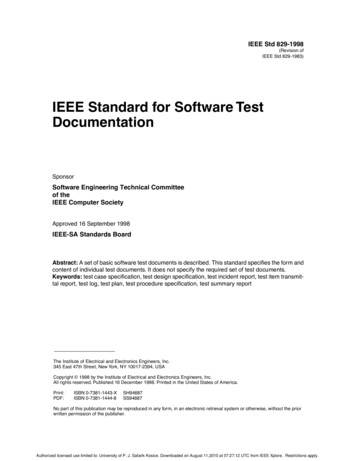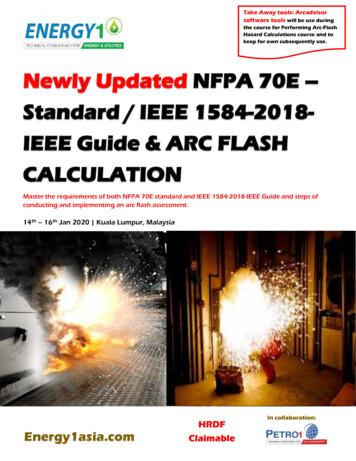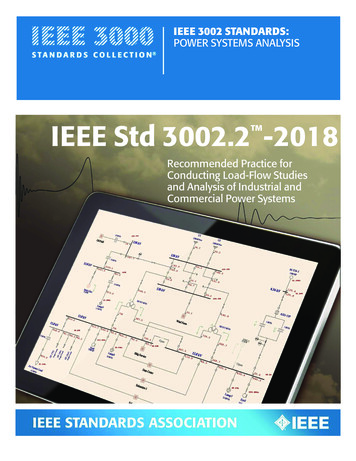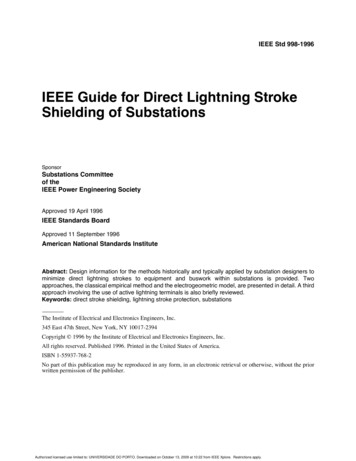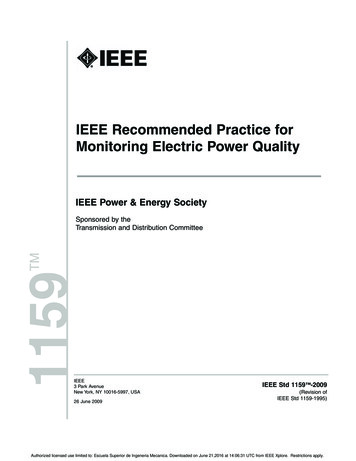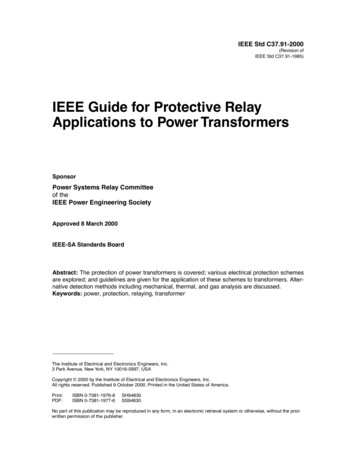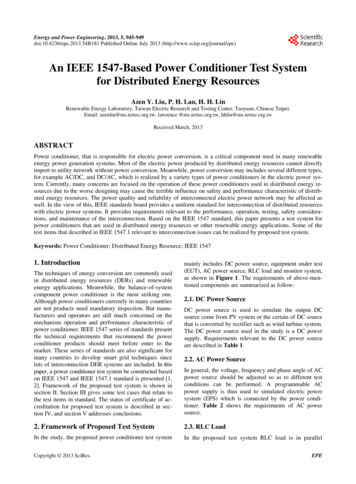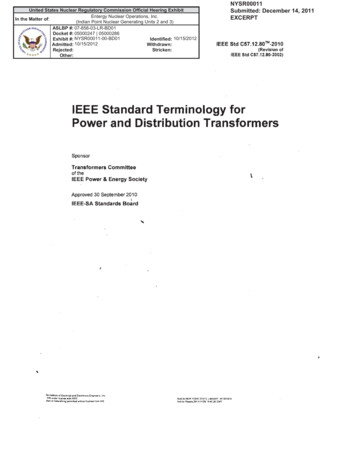
Transcription
United States Nuclear Regulatory Commission Official Hearing ExhibitEntergy Nuclear Operations, Inc.In the Matter of:(Indian Point Nuclear Generating Units 2 and 3)ASLBP #: 07-858-03-LR-BD01c.",t.P-R REG U -4"Docket #: 05000247 05000286Exhibit #: NYSR00011-00-BD01Identified: 10/15/2012"03:.Admitted: 10/15/2012Withdrawn:'"3: iRejected:Stricken: 1-:0'".Other:l \. ",,,,*.NYSR00011Submitted: December 14, 2011EXCERPTIEEE Std CS7.12.80 2010(Revision ofIEEE Std C57.12.80-2002)IEEE Standard Terminology forPower and Distribution TransformersSponsorTransformers Committeeof the\IEEE Power & Energy SocietyApproved 30 September 2010\IEEE-SA Standards Boardh. Instilule of Elwctncal and Electromca Engineers. Inc. IHS under licen. with IEEE;:lIon or networking permitted withoullll::ense trom IHSSold to:NEW YORK STATE LIBRARY. W1201974Not for ReliaIB,2011'1 1/29194526 GMT
.Abstract: This standard is a compilation of terminology and definitions related to electric powerand distribution transformers and associated apparatus. It also includes similar terminologyrelating to power systems and insulation that is commonly involved in transformer technology.Keywords: C57.12.BO, definitions, distribution transformers, insulation, power systems, powertransformers, terminology.,The Institute of Electrical and Electronics Engineers, Inc.3 Park Avenue, New York, NY 10016-5997, USAcr.Copyright 2010 by the Institute of Electrical and Electronics Engineers, Inc.All rights reserved. 17 December 2010. Printed in the United States of America.IEEE is a registered trademark in the U.S. Patent & Trademark Office, owned by the Institute of Electrical and ElectronicsEngineers, Incorporated.PDF:Prtnt:ISBN 978-0-7381-6466-3ISBN 978-0-7381-6467-0ST097021STDP097021IEEE prohibits discrimination, harassment and bullying. For more Information, visit 6.html.No part of this publication may be reproduced in any form, in an electronic retrieval system or otherwise, without the prior written permissionof the publisherCopynght The InsblUle of ElectnC!ll and Electronics Engineers. IncProvided by lHS under license Yll'llh IEEE1140 reproducllon or networking permItted wllhoullicense from IHSSold lo:NEW YORK STATE LIBRARY, W120197(Not for Resllie,2011/11129 19:'-5:26 Gf.tT
IEEE Std C57.12.BO-2010IEEE Standard Terminology for Power and Distribution Transformers3.449 terminal: (A) A conducting element of an equipment or a circuit intended for connection to anexternal conductor. (8) A device attached to a conductor to facilitate connection with another conductor.3.450 terminal board: A plate of insulating material that is used to support terminations of winding leads.NOTE \ -The tenninations, which may be mounted studs or blade connectors, are used for making connections to thesupply line, the load, other external circuits, or among the windings of the machine.NOTE 2-Small tenninal boards may also be tenned tenninal blocks or tenninal strips.3.45] terminal connector: A connector for attaching a conductor to a lead, terminal block, or stud ofelectric apparatus.3.452 terminal pair: An associated pair of accessible terminals corresponding to a phase of a winding.3.453 tertiary winding: An additional winding in a transformer that can be connected to a synchronouscondenser, a reactor, an auxiliary circuit, etc. For transformers with wye-connected primary and secondarywindings, it may also helpa)To stabilize voltages to the neutral, when delta connected.b)To reduce the magnitude of third harmonics when delta connected.c)To control the value of the zero-sequence impedance.d)To serve load.See also.' stabilizing winding.3.454 thermal burden rating of a voltage transformer: The volt-ampere output that the transformer willsupply continuously at rated secondary voltage without causing the specified temperature limitations to beexceeded.3.455 thermal duplicate: A transformer whose thermal design characteristics are identical to a designpreviously tested, or whose differences in thermal characteristics are within agreed upon variations, suchthat the thermal performance of the thermal duplicate transformer shall comply with performanceguarantees established by standards or specifications.3.456 thermally upgraded paper: Cellulose based paper that has been chemically modified to reduce therate at which the paper decomposes. Ageing effects are reduced either by partial elimination of waterforming agents (as in cyanoethylation) or by inhibiting the formation of water through the use of stabilizingagents (as in amine addition, dicyandiamide). A paper is considered as thermally upgraded if it meets thelife criteria as defined in IEEE Std C57.100 [B 14]; 50% retention in tensile strength after 65,000 hours in asealed tube at 110C or any other time/temperature combination given by the equation:15,OO 28028Life(hours) ty 273)I"hereLife - is the life in hoursT - is the aging temperature in DCBecause the thermal upgrading chemicals used today contain nitrogen, which is not present in Kraft pulp,the degree of chemical modification is determined by testing for the amount of nitrogen present in thetreated paper. Typical values for nitrogen content of thermally upgraded papers are between I and 4 percentwhen measured in accordance with ASTM D-982 [82].39Copyright 2010 IEEE. All rights reserved.ute of Electncal and Electromcs Eng1fldtHS Incder I,cerlse With IEEE,elwork.mg perm.lled Wilhout IIcenlie trom IHSSold lo.NEW VORK STATE liBRARY, W1201974Nol for Rasale.2011/111'29 194526 GMT
IEEE Std C57.12.80-2010IEEE Standard Terminology for Power and Distribution Transformers3.457 thermometer method of temperature determination: The determination of the temperature bymercury, alcohol, resistance, or thermocouple thermometer, with any of these instruments being applieddirectly to the medium in which the temperature is being determined.3.458 three-phase circuit: A three-phase circuit is a combination of circuits energized by alternatingelectromotive forces that differ in phase by one third of a cycle, that is, 120 degrees.NOTE-In practice. the phases may vary several degrees from the specified angle.3.459 three-wire type current transformer: One that has two insulated primary windings and onesecondary winding and is for use on a three-wire, single-phase service.NOTE-The primary windings and the secondary winding are permanently assembled on the core as an integralstructure. The secondary current is proportional to the phasor sum of the primary currents.3.460 tight (suffix): Apparatus is designed as watertight, dusttight, etc., when so constructed that theenclosing case will exclude the specified material under specified conditions.3.461 top-oil temperature: The temperature of the top layer of the insulating fluid in a transformer,representative of the temperature of the top liquid in the cooling flow stream. Generally measured 50 mmbelow the surface of the liquid.3.462 top-oil temperature rise: The arithmetic difference between the top-oil temperature and theambient temperature. Syn: top-oil rise.3.463 total losses (transformer or regulator): The sum of the no-load and load losses, excluding lossesdue to accessories.3.464 transformer: A static electric device consisting of a winding, or two or more coupled windings,with or without a magnetic core, for introducing mutual coupling between electric circuits. Transformersare extensively used in electric power systems to transfer power by electromagnetic induction betweencircuits at the same frequency, usually with changed values of voltage and current.3.465 transformer correction factor (TCF): The ratio of the true watts or watthours to the measuredsecondary watts or watthours, divided by the marked ratio.NOTE I-The transformer correction factor for a current or voltage transformer is the ratio correction factor multipliedby the phase-angle correction factor for a speci fied primary circuit power factor.NOTE 2-The true primary watts or watthours are equal to the watts or watthours measured, multiplied by thetransformer correction factor and the marked ratio.NOTE 3-The true primary watts or watthours. when measured using both current and voltage transformers. are equalto the current transformer ratio correction factor multiplied by the voltage transformer ratio correction factor multipliedby the marked ratios of the current and voltage transformers multiplied by the observed watts or watthours. It is usuallysufficiently accurate to calculate true watts or watt hours as equal to the product of the two transformer correctionfactors multiplied by the marked ratios multiplied by the observed watts or watthours.3.466 transient insulation level (TIL): An insulation level expressed in kilovolts of the crest value of thewithstand voltage for a specified transient wave shape; that is, lightning or switching impulse.3.467 transition impedance (in an LTC): A resistor or reactor consisting of one or more units that bridgeadjacent taps for the purpose of transferring load from one tap to the other without interruption orappreciable change in the load current, at the same time limiting the circulating current for the period thatboth taps are used. Normally, reactance type LTCs use the bridging position as a service position, andtherefore, the reactor is designed for continuous loading. See also: transition impedance (IEC 50).40Copyright 2010 IEEE. All right reserved.COPYright The In"mule of Electrlc.al and ElectroniC!!. Engineers, IncProvtded b\l IHS under hcenH With IEEENo reproduction 01 network.lng pfHmltted Without licen5e trom IHSSold fa EW YORK STATE LIBRARY, W1201974Nol for Re580le.2011/11129 19.45·26 GMT Inshluie 01 Eleclr YS und.r license wan or networking PI
IEEE Std C57.12.BO-2010IEEE Standard Terminology for Power and Distribution Transformers3.468 triplex transformer: A transformer constructed of three coils, each having its own core,magnetically independent from each other, and contained in one enclosure to function as a three phasetransformer.3.469 true ratio: The ratio of the root-mean-square (rms) primary voltage or current to,the rms secondaryvoltage or current under specified conditions.3.470 turn ratio of a current transformer: The ratio of the secondary winding turns to the primarywinding turns.3.471 turn ratio of a transformer: The ratio of the number of turns in a higher voltage winding to that ina lower voltage winding.NOTE-In the case of a constant-voltage transforrm:r having taps for changing its voltage ratio, the nominal tum ratiois based on the number of turns corresponding to the nonnal rated voltage of the respective windings. to whichoperating and perfOnllanCe characteristics are n:ferred.3.472 turn ratio of a voltage transformer: The ratio of the primary winding turns to the secondarywinding turns.3.473 two-core regulating transformer: A phase-shifting and/or regulating transformer consisting of aseries unit, which is connected in series in the line circuit and a main or exciting unit that excites thesecondary of the series unit to produce the phase-angle shift or voltage change.3.474 two-phase circuit: A polyphase circuit of three, four, or five distinct conductors intended to be soenergized that in the steady state the alternating voltages between two selected pairs of terminals of entry,other than the neutral terminal when one exists, have the same periods, are equal in amplitude, and have aphase difference 01'90 degrees. When the circuit consists of five conductors, but nol otherwise, one of themis a neutral conductor.NOTE -A two-phase circuit as defined here docs not confonn to the general pattern of polyphase circuits. Actually, atwo-phase, lour-wire or live-wire circuit could more properly be called a lour-phase circuit, but the tenn two-phase isin common usage. A two-phase three-wire circuit is essentially a special case, as it does not confonn to the generalpattern of other polyphase circuits.3.475 ungrounded: A system, circuit, or apparatus without an intentional connection to ground exceptthrough potential-indicating or measuring devices or other very high impedance devices.3.476 uninhibited oil: Mineral transformer oil to which no synthetic oxidation inhibitor has been added.3.477 unit substation: A substation consisting primarily of one or more transformers that aremechanically and electrically connected to and coordinated in design with onc or more switchgear or motorcontrol assemblies, or combinations thereof.3.478 unit substation transformer: A transformer that is mechanically and electrically connected to. andcoordinated in design with, one or more switchgear or motor-control assemblies, or combinations thereof.See also: articulated unit substation, integral unit substation, primary unit substation, secondary unitsubstation.3.479 variable voltage transformer: An autotransformer in which the output voltage can be changed(essentially from turn.to turn) by means ofa movable contact device sliding on the shunt winding turns.3.480 varying duty: A requirement of service that demands operation at loads, and for periods of time,both of which may be subject to wide variation.41Copyright 2010 IEEE. All rights reserved.Ilute of Elect/leal and Eleclroniclt El"lglOetHS, IncI1d@[ license Wilt"! IEEEnet'oNorKlng permr\ted Without hcenlOe from IHSSold lo:NEW YORK STATE LIBRARY, W12018HNot for R8sple.2011/1112Q 19. 5.26 GMT
IEEE Std C57.12.80-2002) IEEE Standard Terminology for Power and Distribution Transformers Sponsor Transformers Committee of the IEEE Power & Energy Society Approved 30 September 2010 \ IEEE-SA Standards Board h. Instilule of Elwctncal and Electromca Engineers. Inc . IHS under licen . with IEEE ;:lIon or networking permitted withoullll::ense trom IHS Sold to:NEW YORK STATE LIBRARY.


